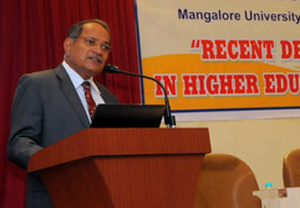
Mangalore, October 5: Integration of technology in education is the need of the hour and the country cannot wait for fulfillment of basic facilities to take educational standards to the next level, said Dr. S Ramananda Shetty, Vice Chancellor, Nitte University.
He was speaking at a seminar on the topic 'Recent Developments in Higher Education in India', organized by the Association of First Grade College Principals, Mangalore University, at SDM College, Mangalore on Friday.
Stating that it is high time that Information and Communication Technologies (ICT) is integrated into higher education in India, Dr. Shetty said that the country cannot keep waiting for demands of 'Roti, Kapda, Makaan' to be fulfilled first. “When IT was proposed for introduction by Rajiv Gandhi, there was a hue and cry in the Parliament on the same thing that the nation needs Roti, Kapda, Makaan, first. But look what IT has done to the country today. If we keep waiting for basic facilities to be fulfilled, we may have to wait for 5,000 years without implementing any reforms”, Dr. Shetty said. Interactive multimedia and components like text, graphics, sounds, pictures, animation and videos play a significant role in modern day teaching, he added.
The world average of students taking to higher education is 23% while India's average is 14%, Dr. Shetty said, stressing on the need to enhance enrollments in educational institutions and setting up of more institutions and universities in the country. With the extension of educational sphere and lack of
80% of the students opt for traditional courses like BA, B.Sc and B.Com while only 20% of students go for professional courses, Dr. Shetty said, adding that a good majority of those taking to these traditional courses are not aware as to why they have chosen them. 60% of the students are dropouts and hence there is a need to increase the capacity in ITC and Polytechnic so that more people are oriented towards skilled and employable jobs. About five lakh students write the IIT-JEE exams for only 9,500 seats, he said, emphasizing on the need to establish more IITs and IIMs and increase in the intake five times the current intake in these institutions.
The government spending on higher education also has to increase, Dr. Shetty said, informing that even after over 60 years of independence, the government is spending 3.7% of the GDP for education of which only 0.66% is earmarked for higher education. Calculations show that India spends mere Rs.2,000 per student in the country, while a country like Malaysia spends Rs.60,000 per student owing to its liberal educational policies and stress given on education, he said.
Rt Rev Dr. J S Sadananda, Bishop, Church of South India (CSI), Karnataka Southern Diocese, was also present.





Comments
Add new comment